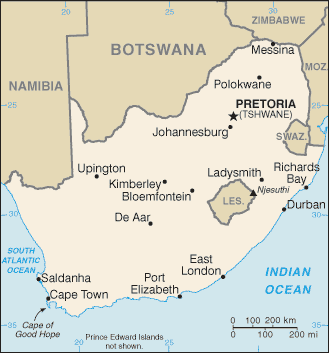| South Africa |
|
|
 |
|
| Geography | |
| Location: | Southern Africa, at the southern tip of the continent of Africa. |
| Area: | total: 1,219,090
sq km land: 1,214,470 sq km water: 4,620 sq km |
| Natural Resources: | Gold, chromium, antimony, coal, iron ore, manganese, nickel, phosphates, tin, uranium, gem diamonds, platinum, copper, vanadium, salt, natural gas |
| Population and Health | |
| Population: | 48,375,645 (July 2014 est.) |
| Age structure: | 0-14 years: 28.3% (male 6,859,518/female 6,815,185) |
| Population growth rate: | -0.48% (2014 est.) |
| Birth rate: | 18.94 births/1,000 population (2014 est.) |
| Death rate: | 17.49 deaths/1,000 population (2014 est.) |
| Sex ratio: | at birth: 1.02 male(s)/female |
| Infant mortality rate: | total: 41.61 deaths/1,000 live births |
| Life expectancy at birth: | total population: 49.56 years |
| Total fertility rate: | 2.23 children born/woman (2014 est.) |
| Current contraceptive use among married women 15-49 years old(any method): | 60% (2007-2012) |
| Unmet need of contraceptive: | 13.8% (2008) |
| HIV/AIDS - people living with HIV/AIDS: | 6,070,800 (2012) |
| HIV/AIDS - deaths: | 235,100 (2012) |
| Literacy: | definition: age 15 and over can read and write |
| Economy | |
| GDP (purchasing power parity): | $595.7 billion (2013 est.) |
| GDP (official exchange rate): | $353.9 billion (2013 est.) |
| GDP - real growth rate: | 2% (2013 est.) |
| GDP - per capita (PPP): | $11,500 (2013 est.) |
| GDP - composition by sector: | agriculture: 2.6% |
| Labor force - by occupation: | agriculture: 9% |
| Population below poverty line: | 31.3% (2009 est.) |
| Inflation rate (consumer prices): | 5.8% (2013 est.) |
| Agriculture - products: | Corn, wheat, sugarcane, fruits, vegetables; beef, poultry, mutton, wool, dairy products |
| Industries: | Mining (world's largest producer of platinum, gold, chromium), automobile assembly, metalworking, machinery, textiles, iron and steel, chemicals, fertilizer, foodstuffs, commercial ship repair |
| Industrial production growth rate: | 0.9% (2013 est.) |
| Exports - commodities: | Gold, diamonds, platinum, other metals and minerals, machinery and equipment |
| Currency (code): | Rand (ZAR) |
| Others | |
| Nationality: | noun: South
African(s) adjective: South African |
| Religions: |
Zion Christian 11.1%, Pentecostal/Charismatic 8.2%, Catholic 7.1%, Methodist 6.8%, Dutch Reformed 6.7%, Anglican 3.8%, Muslim 1.5%, other Christian 36%, other 2.3%, unspecified 1.4%, none 15.1% (2001 census) |
| Languages: |
IsiZulu 23.8%, IsiXhosa 17.6%, Afrikaans 13.3%, Sepedi 9.4%, English 8.2%, Setswana 8.2%, Sesotho 7.9%, Xitsonga 4.4%, other 7.2% (2001 census) |
| Country name: | conventional
long form: Republic of South Africa conventional short form: South Africa former: Union of South Africa abbreviation: RSA |
| Government type: | Republic |
| Capital: | name: Pretoria
(administrative capital) geographic coordinates: 25 42 S, 28 13 E time difference: UTC+2 (7 hours ahead of Washington, DC during Standard Time) note: Cape Town (legislative capital); Bloemfontein (judicial capital) |
| Administrative divisions: | 9 provinces; Eastern Cape, Free State, Gauteng, KwaZulu-Natal, Limpopo, Mpumalanga, Northern Cape, North-West, Western Cape |
| Independence: | 31 May 1910 (Union of South Africa formed from four British colonies: Cape Colony, Natal, Transvaal, and Orange Free State); 31 May 1961 (republic declared) 27 April 1994 (majority rule) |
| Legal system: | based on Roman-Dutch law and English common law; has not accepted compulsory ICJ jurisdiction |
|
|
Source : UN_Demographic and Health Surveys (DHS), Multiple Indicator Cluster Surveys (MICS) and other national surveys; United Nations Population Division Update date: August 2014 |
|